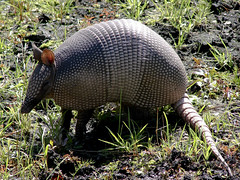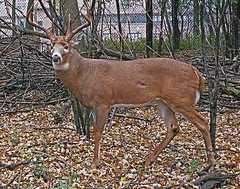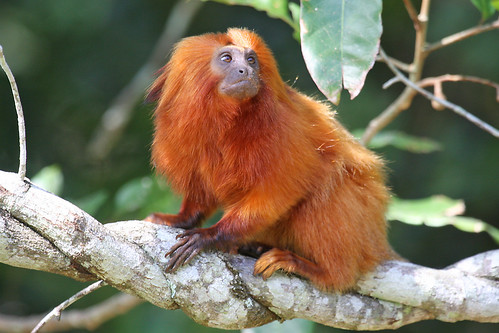隨著整個西半球溫度上升,許多動物可能受限於移動速度而不能找到適合他們棲息的涼爽環境。華盛頓大學研究團隊最新報告指出,西半球有9%的哺乳動物其「避難所」遙不可及,在某些地區,這個比例高達40%。受影響最大的會是靈長類,包括獅狨 (tamarin)、蜘蛛猴、絨猴(marmoset)及吼猴等,部分物種早已名列受威脅或瀕臨絕種名單中。
該研究發表於美國《國家科學院學報》,這是第一個試圖確認在氣候變遷影響到物種棲地時,哺乳動物是否可移動到新的棲地的研究。研究主要撰稿人、華盛頓大學環境及森林科學系Carrie Schloss表示,幾乎整個半球的靈長類都受到棲地減少的影響,平均來說約減少了75%。
報告中提到,「由於氣候變遷可能會超過許多哺乳動物的承載力,在氣候變遷議題下,哺乳動物可能比過去預期的更為脆弱。當我們檢視合適氣候的動物棲地,卻未考慮哺乳動物到新地區的移動或散布,我們將低估了動物的脆弱性。」
Schloss說,西半球的靈長類需費時數年才能達到性成熟,這似乎是他們特別容易受到氣候變化影響的原因之一。另一個原因是,合適氣候的動物棲地越來越萎縮,相較於棲息於山區環境的同類可迅速移動到比較涼爽的氣候環境,熱帶地區的動物必須移動更遠才能找到適宜的棲地。
本研究的共同作者,華盛頓大學環境與森林科學系的副教授Josh Lawler說,「過去超過一半研究物種的科學家預測動物面臨氣候變遷時會擴張活動範圍,實際上因為動物移動的不夠快、來不及遷入新的地方,他們的活動範圍反而會縮小。」
 本研究的科學家總結,在與氣候變遷的「賽跑」中,有三類動物可能成為贏家:肉食動物如郊狼、狼;有蹄類如鹿或是馴鹿;貧齒目(xenarthrans)類動物如犰狳及食蟻獸。
本研究的科學家總結,在與氣候變遷的「賽跑」中,有三類動物可能成為贏家:肉食動物如郊狼、狼;有蹄類如鹿或是馴鹿;貧齒目(xenarthrans)類動物如犰狳及食蟻獸。
研究者分析了西半球的493種哺乳動物,從體重接近兩噸重的麋鹿到只有幾盎司重的鼩鼱都含括在內;只考量氣候變遷因素而不考量其他影響動物分佈(如與其他物種的競爭)的因子,。
為了確認氣候變遷的影響有多迅速,研究團隊整合了10個全球氣候模式及由聯合國跨政府氣候變遷專家小組制訂的中高溫室氣體排放方案。
為計算物種在氣候變遷下必須多迅速的移動方得以生存,他們使用Lawler過去所做每個物種適宜氣候的活動範圍資料。
 研究結果呈現,將會有87%的哺乳動物活動範圍會減少,減少的其中20%是因為移動能力有限,無法到達氣候變異後的適存地。
研究結果呈現,將會有87%的哺乳動物活動範圍會減少,減少的其中20%是因為移動能力有限,無法到達氣候變異後的適存地。
Lawler表示,「對於可能發生的情況,其實我們的數字已相當保守,甚至是樂觀的。因為我們的假設動物為了避開氣候改變,會以最高速率移動。」
另一方面,研究團隊在考量人類造成的穿越障礙(比如城市或農田)也趨於保守。他們使用了過去建立的「平均人類影響公式」來定出動物面對人為設施時的精確位置。他說,「這一點很重要。地球從冰河期到間冰期之間氣候改變,導致物種分佈範圍擴張或縮小時,物種在不同地景間遷移是比現在自由的,因為當時的地景上並沒有人為的農田、4線車道及停車場等設施。」
此研究並未考量如果動物必須穿越由人為地景所需花費的時間。對這些動物而言,保育廊道將扮演拯救整個族群救命者的角色。
Schloss說,「若要幫助一些物種跟上氣候變遷腳步,要特別考量到牠們必須遭遇到許多人為地景開發,因此保育規劃者要把重點放在串起不同區域,提供現有棲地到新適存棲地之間的『連結廊道』。」
而針對對於無法跟上氣候變遷速度移動的物種,Schloss補充,「減少非氣候相關的壓力源,可讓族群具有更強韌的恢復力。然而,減少溫室氣體排放以減緩氣候變遷腳步,或許是唯一確定可以確保物種續存的辦法。」
As the climate heats up across the Western Hemisphere, many animals will not be able to move fast enough to find safe habitats cool enough for their survival.
Safe havens may be out of reach for nine percent of the Western Hemisphere's mammals, and as many as 40 percent in some regions, finds new research from the University of Washington.
Hardest hit will be primates, including tamarins, spider monkeys, marmosets and howler monkeys, some of which are already listed as threatened or endangered.
Nearly all the hemisphere's primates will experience severe reductions in their ranges, on average about 75 percent, said Carrie Schloss, University of Washington research analyst in environmental and forest sciences.
Schloss is lead author of the paper out online today in the journal "Proceedings of the National Academy of Sciences," the first study to consider whether mammals will actually be able to move to new habitats before climate change catches up to them.
"Because climate change will likely outpace the response capacity of many mammals, mammalian vulnerability to climate change may be more extensive than previously anticipated," the scientists write.
"We underestimate the vulnerability of mammals to climate change when we look at projections of areas with suitable climate but we don't also include the ability of mammals to move, or disperse, to the new areas," Schloss said.
Western Hemisphere primates take several years to mature sexually, which is one reason they appear to be especially vulnerable to climate change, Schloss said.
Another reason is that the territory with suitable climate is expected to shrink. Animals in the tropics must go farther to find suitable habitat than those in mountainous regions that can more quickly move up to a cooler climate.
"Indeed, more than half of the species scientists have in the past projected could expand their ranges in the face of climate change will, instead, see their ranges contract because the animals won't be able to expand into new areas fast enough," said co-author Josh Lawler, UW associate professor of environmental and forest sciences.
Winners in the climate change race are likely to come from three groups of mammal species - carnivores such as coyotes and wolves, ungulates like deer and caribou, and xenarthrans, the group that includes armadillos and anteaters, the scientists conclude.
The analysis looked at 493 mammals in the Western Hemisphere ranging from a moose that weighs nearly two tons to a shrew that weighs just a few ounces. Only climate change was considered and not other factors that cause animals to disperse, such as competition from other species.
To determine how fast climate change might occur, the UW researchers integrated 10 global climate models and a mid-high greenhouse gas emission scenario developed by the UN Intergovernmental Panel on Climate Change.
To calculate how quickly species must move to new ranges to survive climate change, they used previous work by Lawler that shows the areas with climates suitable to each species.
The scientists found that 87 percent of mammal species are expected to experience reductions in range size and 20 percent of these range reductions will likely be due to limited dispersal abilities as opposed to reductions in the area of suitable climate.
"Our figures are a fairly conservative - even optimistic - view of what could happen because our approach assumes that animals always go in the direction needed to avoid climate change and at the maximum rate possible for them," Lawler said.
The researchers also were conservative, he said, in taking into account human obstacles such as cities and crop lands that animals encounter as they try to escape the heat.
They used a previously developed formula of "average human influence" that pinpoints regions where animals are likely to face intense human development.
"I think it's important to point out that in the past when climates have changed - between glacial and interglacial periods when species ranges contracted and expanded - the landscape wasn't covered with agricultural fields, four-lane highways and parking lots, so species could move much more freely across the landscape," Lawler said.
The study does not account for transit time if animals must go completely around human-dominated landscapes. For these animals, conservation corridors will serve as life-savers that may contribute to the survival of entire species.
"Conservation planners could help some species keep pace with climate change by focusing on connectivity - on linking together areas that could serve as pathways to new territories, particularly where animals will encounter human-land development," Schloss said.
"For species unable to keep pace," she said, "reducing non-climate-related stressors could help make populations more resilient, but ultimately reducing emissions, and therefore reducing the pace of climate change, may be the only certain method to make sure species are able to keep pace with climate change."






